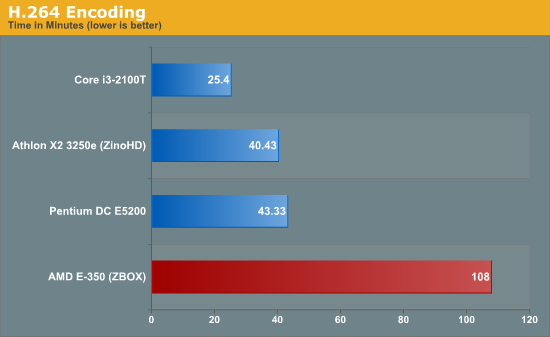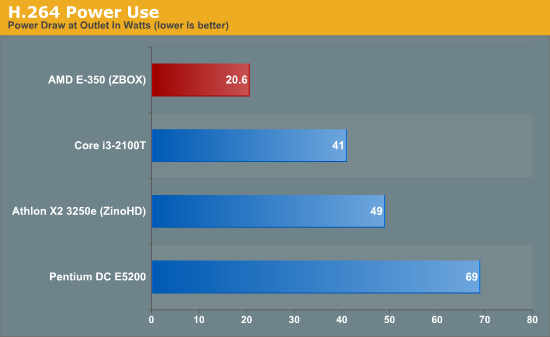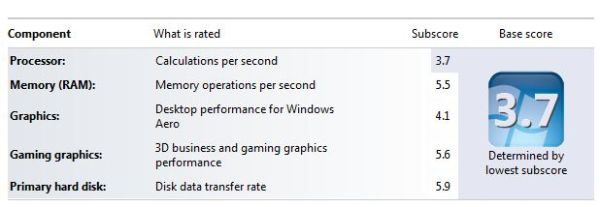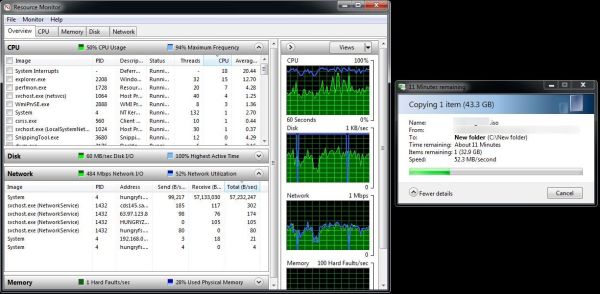Zotac ZBOX: Brazos Goes HTPC
by Andrew Van Til on June 9, 2011 5:00 PM ESTSystem Performance and Power Use
Starting out with the Windows Experience Index (WEI) from the 32-bit version of Windows 7 Ultimate, we can see that the E-350’s 1.6GHz CPU is the lowest scoring component. We wouldn’t place too much stock in WEI, but is does confirm the overall design: the E-350 is a low power and not very fast CPU paired with a moderately fast GPU.

To get a better feel for how that score translates into actual performance, a thirty minute 480i AVC/AC3 file was transcoded using a popular software based h.264 encoder, Handbrake 0.94. Looking at the results above, we can see that the AD03BR-PLUS-U’s CPU is the slowest in the bunch; even substantially outperformed by the first generation Zino HD’s 1.5GHz Athlon X2 3250e. Atom would be slower still, but we’ll bypass that well-trodden path in this discussion.

The lack of CPU prowess is not without benefits, however, as the E-350 has a clear advantage in power consumption. It uses only half the power required by the Core i3-2100T under load. So you use half the power and one-fourth the encoding performance, but there’s still the question of media decoding support. If you want to do video encoding on your HTPC, you’ll be better off with a faster CPU.
With the above charts as a baseline, it should be obvious that application load times and menu navigation inside programs like Windows Media Center will be somewhat slower compared to more powerful CPUs, but in day-to-day use the AD03BR-PLUS-U’s performance was not generally a blocking issue. There were some conditions however where it was problematic however, most notably when stressing the on-board network interface device (NIC). This was especially true when using the drivers provided on the CD and on ZOTAC’s website, where playing large files across the network taxed the CPU past the point where flawless playback was possible.
Utilization dropped to a much more manageable level after installing the most recent set of drivers from Realtek, but as we can see from the screenshot above taken after updating the drivers, it is still possible to experience a CPU constraint during playback if secondary activities/processes are not prioritized appropriately.
| Media/Power Performance Table | |||
| State | Power Range | Average Power | Average CPU |
| S4/S5 | 1.1W | 1.1W | N/A |
| S3 | 1.0-1.4W | 1.2W | N/A |
| IDLE | 10.0-11.2W | 10.2W | 0-2% |
| Full CPU Load (Prime95) | 19.3-19.9 | 19.7W | 100% |
| Netflix SD (Silverlight*)*** | 19.5-21.0W | 20.3W | 92% |
| Netflix HD (Silverlight*)** | 19.6-21.1W | 20.7W | 100% |
| YouTube 480p (Flash) | 15.4-16.1W | 15.6W | 31% |
| YouTube 1080p (Flash) | 18.3-20.7W | 20.3W | 53% |
| 3D MVC/DTS-HD BD ** | 23.6-25.2W | 24.2W | 79.05% |
| AVC/DTS-HD BD | 21.6-23.1W | 21.9W | 31.68% |
| VC-1/DTS-HD BD | 20.6-21.5W | 21.2W | 23.82% |
| AVC/TrueHD BD | 22.0-22.6W | 22.2W | 31.94% |
| VC-1/TrueHD BD | 21.7-22.3W | 22.1W | 22.66% |
|
VC-1/TrueHD M2TS (MPC-HC DXVA/ffdshow) |
16.0-16.5W | 16.1W | 25.42% |
|
VC-1/TrueHD M2TS (MPC-HC FFmpeg*/ffdshow)** |
18.6-20.1W | 19.2W | 66.63% |
|
VC-1/DTS-HD M2TS (MPC-HC DXVA/ffdshow) |
15.8-16.6W | 16.2W | 12.89% |
|
VC-1/DTS-HD M2TS (MPC-HC FFmpeg/ffdshow)** |
18.0-21.4W | 19.4W | 55.66% |
|
VC-1/TrueHD M2TS (Arcsoft/ffdshow) |
15.1-15.8W | 15.4W | 22.78% |
|
VC-1/DTS-HD M2TS (Arcsoft/ffdshow) |
15.5-16.6W | 16.1W | 9.16% |
|
AVC/TrueHD M2TS (MPC-HC DXVA/ffdshow) |
17.2-18.0W | 17.5W | 29.38% |
|
AVC/TrueHD M2TS (MPC-HC FFmpeg*/ffdshow)** |
19.0-20.5W | 19.5W | 84.15% |
|
AVC/DTS-HD M2TS (MPC-HC DXVA/ffdshow) |
16.7-17.8W | 17.4W | 15.90% |
|
AVC/DTS-HD M2TS (MPC-HC FFmpeg*/ffdshow)** |
18.6-20.9W | 19.4W | 75.50% |
|
AVC/TrueHD M2TS (MS DXVA/ffdshow) |
17.6-18.5W | 17.8W | 33.41% |
|
AVC/DTS-HD M2TS (MS DXVA/ffdshow) |
16.8-18.4W | 17.4W | 21.07% |
* Software decoder
** Severe playback issues observed
*** Minor playback issues observed
With a maximum power draw of 25.2W and an idle power of ~10.2W measured at the wall with a Kill A Watt P4460, we can again see where AMD’s Fusion realizes significant benefit from the platform’s design. There are several important points to take away from the above table, with the most important being the relative strengths (GPU) and weaknesses (CPU) of the ZBOX AD03BR-PLUS-U during media playback. Where decoding is possible using the AMD 6310’s UVD, performance is good; on the other hand, when we push those duties onto the CPU performance is not. In the case of HD content, the result is generally unwatchable.
For local content that is not a problem, with DXVA support provided from all of the major commercial players, and from the free/open source software (FOSS) community via MPC-HC as well. Internet content using Flash is only limited by the quality of the media and available bandwidth. Netflix is a different story, however, because it relies on Silverlight for playback, which does not currently support GPU decoding. This should be addressed with Silverlight 5, but it’s not in the current beta release. Interestingly, HDMI 1.4 3D Blu-ray playback is at least partially supported by the driver (i.e. playback begins and the display switches to 3D mode), but it was not watchable so the feature will need to be disabled in the player software if watching MVC discs.












36 Comments
View All Comments
dagamer34 - Thursday, June 9, 2011 - link
Needs built-in IR, and then we can call it an HTPC.amdhunter - Saturday, June 11, 2011 - link
You can always use a vnc based remote control program with your Android or iPhone.Khato - Thursday, June 9, 2011 - link
There's been a troubling trend of late in a number of Anandtech articles where testbed configurations are not even mentioned in passing. While it's not as important here for the most part, when it comes to a comparison of power consumption, especially at low levels, the power supply used can play a larger part than the CPU. With the information available in this article, the conclusion would be that the E-350 based ZBOX is very efficient and an excellent low power choice... Whereas an article on another site that compared similarly configured systems using the same power supply had an E-350 at 100% CPU load at 23.9 watts while the same load on an i3 2100T was only at 33.6 watts. As well, the i3 2100T system actually idled a bit lower, 9.8 watts vs 12.8 for the E-350.It's details like that that make me quite interested to see what Zotac could come up with in terms of a sandy bridge based ZBOX.
zupzop - Thursday, June 9, 2011 - link
The article of xbitslabs entitled "every watt counts" you refer to, is completely misleading. If every watt would count they would have compared the E350 with the economical MSI board (they tested themselves), rather than with the energy wasting Gigabyte board.against the i3 2300. If you look for the MSI E350 on the xbitlabs pages you can verify for yourself that is consumes less power than the i3 2100 in every test reported(of course, given the testbed configuration used for the i3 2100).
Xbitlab data:
Power consumption:
Test -> Idle, CPU-B , GPU-B, CPU+GPU B
E350 + MSI 7.3 15.8 17.5, 22.1
E350 + Gigabyte 12.8, 23.9, 27.7, 31.2
i3 2100 9.7, 33.6, 22.8, 38.9
(see http://www.xbitlabs.com/articles/cpu/display/amd-e... )
(and http://www.xbitlabs.com/articles/cpu/display/core-... )
Khato - Thursday, June 9, 2011 - link
Thanks for the further information. It's another excellent example of how the testbed configuration at these power consumption levels can have a marked effect upon how a product compares.duploxxx - Friday, June 10, 2011 - link
xbitlabs also forgets that only for the price of the i3 2300T you can buy the brazos board+cpu......lets see how they fare soon against the E2and A4 launch LIano, in the end that is where an i3 should be compared with.
octagonalman - Friday, June 10, 2011 - link
Xbitlabs didn't forget that - the price difference is mentioned clearly in the conclusion.burntham77 - Friday, June 10, 2011 - link
Just another reason why I have become a fan of MSI.duploxxx - Friday, June 10, 2011 - link
Regarding the review:This is a design build for home consumers, so therefore first of all this should have been compared against those in the same class... Atom and ION like builds i.s.o these stupid compares with desktop parts. Sure those might have also a good low power and performance quality but then you get into the self-made designs with personal touches.
THis is becomming a habbit for anandtech site, compare with what needs to be compared, it's always possible to find a cpu and gpu that will do things in a more performing way, if you want to review the ultimate self-made htpc , start building a few and compare those against each other.
Khaot:
THe reason why no provider will put a SNB inthere is first of all the price it will be much much more expensive from a cpu and mobo point of view to build and secondly since although those cpu are low power consumption they have a much higher TDP range which will force them to build and design towards the actual TDP..... not some homebrew user who makes something (which will never be that thin btw) and doesn't care about rated TDP, when intel will release lower power cpu there will also be again a pricetag.
Randomblame - Thursday, June 9, 2011 - link
I just put together an htpc in the bedroom from the pile of broken acer laptops I have. It is just the bottom of the laptop without a battery and a few of the bottom covers have been replaced with patches of duct tape but it's small, quiet, efficient, powerful enough to stream movies off my desktop, and the best part is it has a keyboard and touchpad built in - small footprints ftw